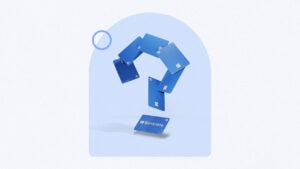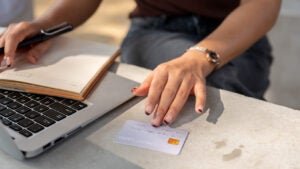Why a wallet full of credit cards is so not an emergency fund

It may seem like a quick fix, but relying on your credit card to cover a large unexpected expense can have long-lasting effects.
A recent Bankrate survey found that 15 percent of Americans would finance an unexpected expense of $1,000 or more with their credit card, the second-most commonly cited payment method after using savings.
Accumulating debt using your credit card as an emergency fund can prevent you from building an actual emergency savings account, leaving you vulnerable to the next unexpected expense.
By their very nature, you can’t anticipate emergencies, but developing a plan beforehand can keep you from taking on dangerous high-interest debts and risking your credit.
“Sometimes life happens,” says Kate Welker, a financial planner at Irvine Wealth Planning Strategies. With her clients, Welker says, “The biggest things I try to emphasize to take away are just plan for what you can and do damage control if you need to.”
How an emergency credit card could be detrimental
Using a credit card for unexpected expenses when you can’t pay them in full can turn your one-time cost into months or years of debt payoff.
For the 38 percent of credit card users already accumulating interest each month by carrying a balance, a leaky roof or emergency room visit could be a big setback, especially with credit card interest rates averaging 17.8 percent.
“Most credit cards, if not all of them, have a variable interest rate, which means that the interest rate keeps changing over time,” says Abhinav Anand, head of consumer loans for Marcus by Goldman Sachs. “Especially in today’s world when the Fed keeps changing interest rates every quarter, those variable rates keep going up, they’ll end up paying more in interest and it will take more time to pay off that debt.”
Even if you keep a separate credit card on hand dedicated to emergencies, you may risk losing access to your full credit limit or your issuer canceling the card.
Card issuers can close accounts due to delinquency, inactivity or default without notice. If your emergency plan relies on an inactive card, you may not know it’s been canceled or curtailed until it’s too late.
Other financial options for the unexpected
If an emergency occurs before you’ve had the chance to build your savings, look into other ways to avoid high-interest credit card debt.
Though you shouldn’t use it in place of an emergency savings account, a personal loan may be a wiser choice than a credit card if you’re unable to pay off the expense in full immediately. Compared to the 15 percent of people in Bankrate’s survey who would finance an emergency with their credit card, only 6 percent would take on a personal loan.
“With a personal loan with a fixed interest rate, customers are at least shielded from interest rate changes that happen,” Anand says. “They know they have a fixed amount to pay each month and in the next 10, 15, 24 months that debt will be paid off.”
Build your emergency savings instead
To reduce your risk of going into debt to pay for an unexpected cost, start building your emergency savings fund today.
Ideally, you should have three to six months’ worth of expenses saved for a financial emergency or income loss. Just over the past year, 36 percent of Americans faced an unexpected expense of $5,000 or more.
If $5,000 or six months of expenses sounds daunting, start small.
“Sometimes it helps to have mini goals,” Welker says. “The first thing, just get $1,000 in there, because $1,000 is going to cover a lot of expenses.”
Even if you can only contribute $20 in the beginning, consistent payments add up. Evaluate your budget and your unnecessary expenses and determine an amount that you feel comfortable adding to your savings each month.
If you have had to use your credit card for unexpected expenses, pay off the balance as quickly as you’re able, then dedicate the same amount you were putting towards that debt each month to your savings instead. Consider a balance transfer credit card to reduce your interest payments.
Anand says developing a habit of making regular, monthly deposits into your emergency savings is one of the most important things you can do to keep yourself out of debt and stay prepared for the unexpected.
Where to keep an emergency fund
Make sure your emergency fund is easily accessible, such as a high-yield savings account that will accumulate interest over time. If you’re worried about the temptation of an easily accessible account, Welker recommends asking your bank to hide the savings from your online view or opening an account with another bank that you won’t check as often.
Other options, like a short-term CD or money market account, may have more restrictions than a savings account, but usually earn higher interest.
Earning interest shouldn’t be your main objective, though. You should view your emergency savings as an insurance policy rather than an investment. It’s there not to build wealth but to ensure that you don’t have to borrow at high rates or dip into or reduce contributions to your actual investments.
When is it okay to use an emergency credit card?
Once you’ve built your emergency savings, Anand and Welker say there’s nothing inherently wrong with using your credit card to pay off an emergency, as long as you can guarantee you’ll pay off the balance in full that month.
“Commit to paying off that bill,” Welker says. “But you can turn something that’s a negative into a positive, whether it’s travel rewards or cash-back rewards. You could make some money on it. As long as you know, personality-wise, you’re actually going to be able to do that.”
Only use your credit card as a complement to your emergency savings though, rather than a replacement for it.
Always pay off your high-interest debt and build your emergency savings first, then you can determine whether to use a credit card for an emergency or withdraw directly from your savings.
Learn more:
- See savings account and money market rates nationwide
- Most Americans wouldn’t cover an emergency with savings
- How to start and build an emergency fund
Why we ask for feedback Your feedback helps us improve our content and services. It takes less than a minute to complete.
Your responses are anonymous and will only be used for improving our website.
You may also like

How to do a credit card balance transfer




